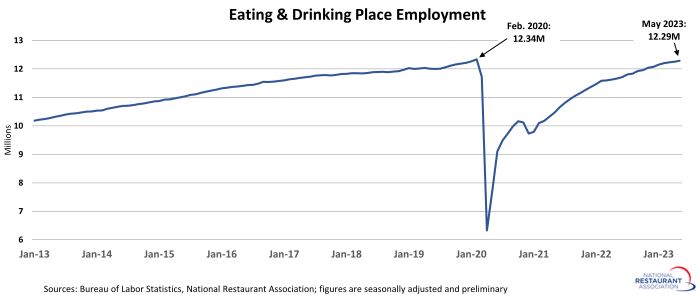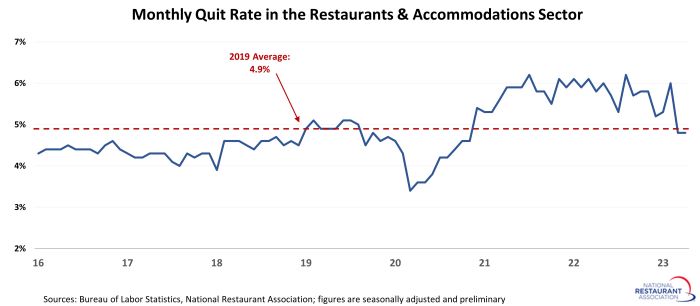Restaurants added 33,000 jobs in May
The restaurant industry continued to expand payrolls at a moderate pace in May. Eating and drinking places* added a net 33,100 jobs in May on a seasonally-adjusted basis, according to preliminary data from the Bureau of Labor Statistics (BLS).
May’s increase followed similar gains in March (32,900) and April (22,400). Restaurant employment growth during the last three months was down somewhat from the average monthly gains of 51,000 jobs during the previous 12 months.

May marked the 29th consecutive month of employment gains in the restaurant industry – representing a total increase of more than 2.5 million jobs.
Driven by the steady growth, the restaurant workforce is inching closer to a full recovery to pre-pandemic levels. As of May 2023, eating and drinking places were 51,700 jobs – or 0.4% – below their February 2020 employment peak.

Employee retention is improving
Although restaurant job growth slowed somewhat in recent months, operators are having more success keeping the employees that they have.
An average of 4.8% of employees in the combined restaurants and accommodations sector quit their jobs in March and April, according to Job Openings and Labor Turnover Survey (JOLTS) data from BLS.
That was a full percentage point below the average monthly quit rate of 5.8% during the previous 24 months (March 2021 – February 2023). In addition, it was just below 2019’s average monthly quit rate of 4.9%.
If this trend holds, it could signal a return to more typical workforce churn in the hospitality sector, which would help ease the industry’s labor challenges.

Note: The monthly quit rate data presented above are for the broadly-defined Accommodations and Food Services sector (NAICS 72), because the Bureau of Labor Statistics does not report data for restaurants alone. Eating and drinking places account for nearly 90% of jobs in the combined sector.
*Eating and drinking places are the primary component of the total restaurant and foodservice industry, which prior to the COVID-19 pandemic employed more than 12 million out of the total restaurant and foodservice workforce of 15.6 million.
Read more analysis and commentary from the Association's chief economist Bruce Grindy.